
|   |

|   |
Nartaka Festival 2012 - Veejay Sai & Lalitha Venkat e-mail: vs.veejaysai@gmail.com / lalvenkat@yahoo.com Images courtesy: Sreedhar Vaidya October 13, 2012 For a good half a dozen years, the Natyanjali Trust founded by the late Jayalakshmi Satagopan has been organizing Nartaka Festival dedicated totally to male dancers. The sixth edition of the festival was held at the Bharatiya Vidya Bhavan, Chennai, from October 5 – 7, 2012. Day 1: Veterans galore As announced earlier, the festival did not open with the Bharatanatyam performance of Bhavajan Kumar. News was in that he had trouble getting a visa and had to unfortunately miss out performing. The evening opened with a dashavataram presentation by L Narendra Kumar. While Narendra had some good ideas in his choreography, a large part of the production became monotonous. The only two accompanists he was supported by were NK Kesavan on the percussion and Girish Menon on high-pitched vocals. As Narendra dragged on each and every avataram of Lord Vishnu in slow-motion, one could help but thank Vishnu for not having more than ten avatarams. Narendra’s choreography would establish each of Vishnu’s avatarams with Girish singing ‘Om Namo Narayana’ before he began miming the next. He concluded his dashavataram choreography into a kriti by Annamacharya ‘Nanati brathuku natakamu.’ Once again the pathos needed for this highly philosophical composition didn’t come across from Narendra’s dance. If he can tighten his choreography, Narendra can make this piece into a better one. 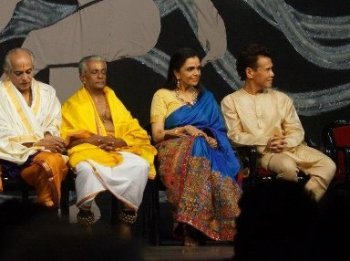 Prof. Janardhanan, Prof. Balagopal, Dr. Anita Ratnam, Ramli Ibrahim Courtesy: Kavitha Ramu After the performance was the felicitation ceremony that was much-looked forward to. Two veteran dancers from Kalakshetra, Prof. Janardhanan and Prof. C K Balagopalan were honoured by renowned dancer Dr. Anita Ratnam. Speaking at the occasion, Anita fondly reminisced of her days with these veterans at Kalakshetra and how Rukmini Devi (fondly addressed as ‘Athai’) worked with dancers of those times. After the small ceremony, Prof. Janardhanan performed an excerpt from the Srikrishna Karnamritam in a clear combination of Bharatanatyam and Kathakali. A bit slow but one could see flashes of good old-school Kalakshetra style. Following him, veteran dancer Narasimhachari presented a ‘Shiva Stuti’ and a padam ‘Yaar enna sonnalum’ by Oothukadu Ventaka kavi set to Ragam Manirang. 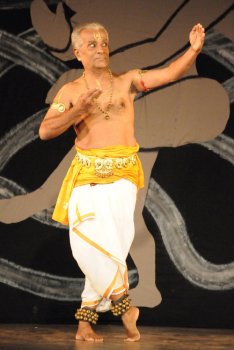 Prof. CK Balagopal The best for the evening came from Prof. CK Balagopal who performed a Jayadeva Ashtapadi ‘Priye charusheele.’ 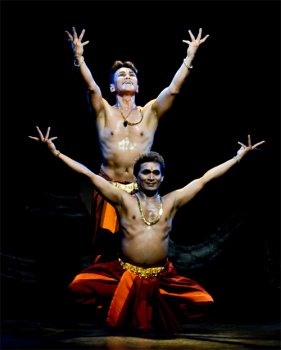 Ramli Ibrahim & Shanmuga Sundaram This was followed by a rather bland performance by Ramli Ibrahim to recorded music. Everyone knows Ramli’s strength lies in his Odissi dance and Bharatanatyam isn’t the best for him. Shanmuga Sundaram who is otherwise a good dancer, ended up being disappointing in a small duet thillana with Ramli. It would have been good to see a solo by Shanmuga Sundaram. Being an organizer and performer in the same festival must have taken its toll on both the dancers as the fatigue was evident on their faces. Day 2: Two shining stars 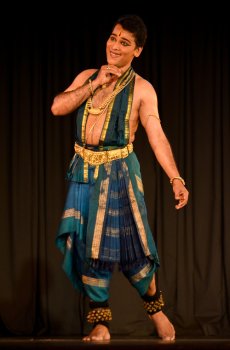 A Lakshman The second day almost made up for the first. A solo recital by A Lakshman opened the evening. Performing the famous padavarnam ‘Innum yen manam’ in Ragam Charukeshi composed by the renowned violin maestro Lalgudi Jayaraman, with some excellent recorded music by Hariprasad, Lakshman portrayed the various leelas of Lord Krishna as ‘Kamala kanna’ and ‘Manivanna’ as the maestro wrote. From Poothana moksham to Rasa lila, an array of wonderful narratives were delivered with finesse. In the charanam ‘Kuzhal udum azhaga kanna,’ Lakshman’s attempt felt a bit slowed down. This could have been the effect of recorded music. He followed that with a Sarangapani’s ‘Chitike vesithe’ set to Mohana Ragam. Lakshman is gifted with excellent abhinaya unlike many other male dancers and he goes out of his way to flaunt this talent of his. Why not! He concluded with a thillana in Ragam Kadanakuthoohalam composed by renowned Carnatic vocalist Mangalampalli Balamurali Krishna. While Lakshman’s performance was fine, it would have certainly been far better to see him dance to live music, than to recorded. But then, he was a last minute stand in for the Chhau dancer who cancelled his trip only two days earlier due to an emergency situation in his family. 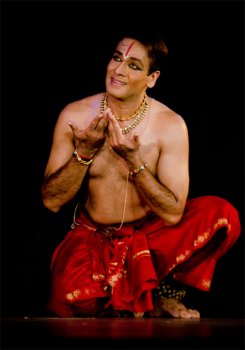 Sathyanarayana Raju That was followed by an excellent performance for the entire festival by Bangalore-based Sathyanarayana Raju. A senior disciple of late Guru Narmada, Sathya is one of the most under-noticed dancers on the concert stages. He presented ‘Saami Ninne Kori’, a traditional varnam of the Thanjavur quartet. With clear lines and solid jatis, Sathya managed to deliver the essence of the Thanjavur baani, undiluted to the audiences. His every jati won him applause. It was a sight to see. He followed that with a devarnama of Purandara Dasa, ‘Hanumantha deva’ in praise of Lord Hanuman. Narrating the various leelas of Hanuman, as Lord Rama’s loyal servant, as his messenger to Lanka, his pranks in Lanka and much more, Sathya’s sancharis kept the audience in rapt attention and awe. Added to the dance was some excellent vocal support by Vidhya and nattuvangam by Shakuntala Prabhat. Lingaraju’s fingering technique on his mridangam helped Sathya improvise in his sancharis and they worked like an excellent team. It would have been good to see at least a half-full house at the festival. A scanty audience was a disappointment for those who came. Most male dancers crib and cry over no organizer or sabha calling them for performances. And here is a festival dedicated totally to male dancers and the hall looked embarrassingly empty. Male dancer fraternity needs to certainly get their act right if they wish to be equally supported or encouraged. Veejay Sai is a writer, editor and a culture critic.  Courtesy: Deepak Kurki Shivaswamy
The final evening of the 6th Nartaka Festival started with contemporary dance by Amaresh, Charan CS and Deepak Kurki Shivaswamy from Bangalore. They presented 3 items in one continuous sequence. Amaresh and Charan emerged from the audience after distributing kalkandu (tiny sugar cubes) to put us in a sweet mood as well as establish a connection between audience and performer. Charan continued to do a solo titled ‘Flickers,’ about the way the mind functions, how with ever changing thoughts, it flickers non stop - thought patterns, colors, everything around affects the brain. Use of different color material (the shirts he wore in layers) and appropriate music conveyed the different moods and changes that happened with every passing movement. Charan smiled down at us in the front row (we smiled back at him every time!) and switched between smooth and aggressive movements like a schizophrenic personality, shedding one layer of clothing after another. Some robotic movements, twirls and off with his tan shirt as percussion picks up speed. Smiles and aggression alternate and now it’s off with the orange shirt. Charan moved along the front edge of the stage as Tibetan chants lent a meditative mood. As the music changed to cacophony, it was off with the beige shirt. Performing to a female voice and thumping sound like that of a heartbeat, the dancer shed his mauve shirt and down to his last item of clothing, white shirt and black knee length tights, he walked towards the back of the stage and disappeared into the backdrop. In spite of wearing so many layers, Charan still managed to appear slim! Enter Deepak to present ‘Lvoe – a non romantic solo’ that questions the unnecessary romanticism of materialistic things in life. This work was created at The Gati Summer Dance Residency 2011. With the use of varied headgear, he moves to idealistic music to communicate his comments on religion, society and politics. He blindfolds himself and Amaresh drops in to fling a helmet at him. Removing the blindfold, Deepak portrays the people one sees on a normal day with the help of minimal accessories - a skull cap; Muslim cap and kneeling in prayer; remaining in headstand for quite a few seconds; we hear loud music on his ipod till he puts on the headphones and dances to the music that only he hears now. One image he consciously brought into the narrative was a scene from the Mumbai blasts. At one point, he falls off the stage down to the auditorium floor and lies down flat for a few seconds before jumping back on to the stage and gives us a faint smile/ smirk (we smiled back!). The changing of personality and the ordinariness of the people portrayed were conveyed effectively though Deepak did announce in the beginning that they were trying to do something new and to receive the presentation with an open mind. The finale had the 3 dancers in ‘Three souls’ continuing to perform amidst all the paraphernalia of the first two items strewn on the stage. Clad in orange vests (like what road workers wear), each represented a part of our social system. Deepak is affected by “the changing landscape and the people who are responsible for this change.” Charan’s cry against capitalism depicted “groups of people working for groups of people, but while the latter reap the benefits, the former not only get the least but are abused too.” Amaresh’s pleas were for the “plight of the farmers.” Walking with his father past green pastures and trees in his early years, he saw pesticide was used only to kill the pests invading their plants. But now, the same pesticide is being used to end their miserable lives. This drama was played out in the small square on the left front side of the stage strewn with white powder. Social comments were sensitively portrayed. Simple symbolism like putting shoes on the head of the downtrodden, the capitalist standing on the poor people’s back or enjoying his soda, the farmer strewing first the white pesticide powder on his plants and then ingesting it were evocatively brought out in the dance theatre. It was very well received by the audience who could identify with all these issues and appreciated with thunderous applause. “It was worth coming to Chennai just to see these three performers. In India, one sees contemporary based on Indian dance forms but this is very authentic contemporary technique like one sees in the West. Though the aesthetics were urban and there is strong reference to the Indian scenario, there is no connect to classical dance. In the third piece the message is very clear without being illustrative and really hits you towards the end. The dancers have shown their sensitivity as well as confidence about their work. It is refreshing to see this contemporary work by these three talented dancers who are so different in build, appearance and movement, yet they worked so well together,” said an appreciative Ramli Ibrahim. Talking to the dancers post performance was a revelation. While the three are friends, they are also part of a collective called the Kha Foundation dedicated to promoting movement arts, performance, music and design, that was registered 6 months back in Bangalore. At present they have 15 members and look forward to interacting with different communities and different cultures, to exchange artistic ideas and share their work. Through this mutual exchange, the aim is to build a broad network that allows the members to regularly work in different parts of India and also abroad. While Deepak is a trained dancer, Charan and Amaresh (both are also qualified yoga teachers) came from a theater background into dance. All performers have been associated with Attakkalari Centre for Movement Arts. Originally ‘Three souls’ is performed with shoes on, but in deference to the next program being spiritual in nature, they performed that evening minus footwear. They plan to expand the piece to a full length one hour or so to be premiered at The Park’s New Festival in September 2013. Deepak and Charan recently won the Prakriti Excellence in Contemporary Dance Awards for 2012. 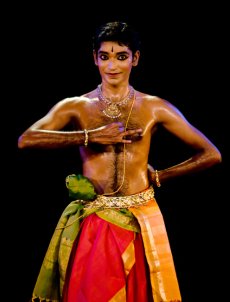
Rakesh
The finale of the festival was a Bharatanatyam performance by Rakesh who has trained in Kalakshetra, Chennai. He presented a kauthuvam of the Tanjore Quartet, “Manavi chekona rada" Varnam by Tanjore Quartet composed by Ponniah Pillai and choreographed by Adyar K Lakshman, “Unnai thoodhu anuppinen” a Padam of Ghanam Krishna Iyer in Saveri ragam choreographed by Bragha Bessell and concluded with a Thillana in Valachi composed by Bhagavatula Seetharama Sarma. He was accompanied by G Srikanth on vocal, Ramesh Babu on mridangam, Gireesh on nattuvangam and Eswar on the violin. He is yet to improve on his facial expressions, but his youthful zest carried him through the evening and his spirited performance was cheered on by his many supporters in the audience. Chennai is afflicted by this phenomenon of supporters turning up for only their dancer friend if it is the second show. If it is the first show, they leave immediately after and the next performer be damned. And if 2 or 3 events are taking place simultaneously, and if the publicity is inadequate, as was the case in this festival, to attract an audience gets harder. Among the few male dancers who attended, Thiruchelvam, a talented dancer and choreographer, spoke ruefully of the audience being taken in by the gloss of publicity for mediocre shows, just like the hype of a mediocre film is boosted by high publicity to attract viewers. The Nartaka Festival had done reasonably well the last two years, but this year was rather disappointing in audience turn out. So, apart from paying attention to the performance line-up, the organizer definitely has to step up publicity for this festival, and ensure that the performers find joy in performing at the festival. Lalitha Venkat is the content editor of narthaki.com |